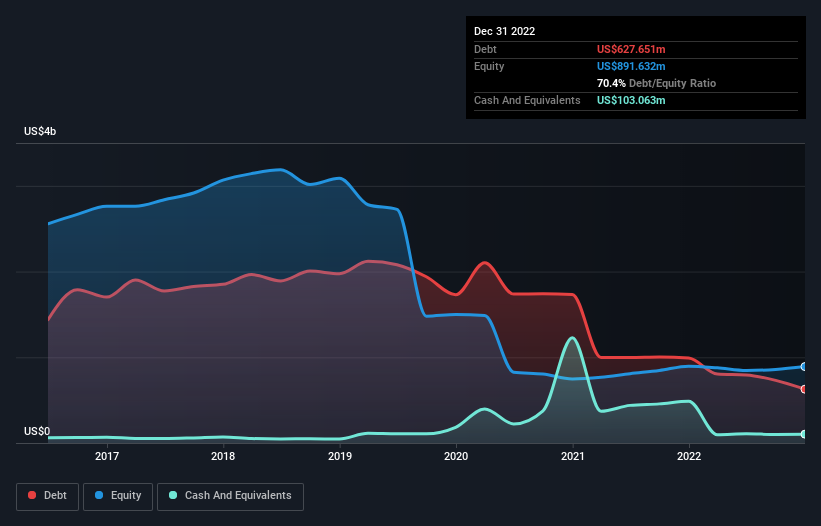- United States
- /
- Healthcare Services
- /
- NYSE:MD
Pediatrix Medical Group (NYSE:MD) Has A Somewhat Strained Balance Sheet

Legendary fund manager Li Lu (who Charlie Munger backed) once said, 'The biggest investment risk is not the volatility of prices, but whether you will suffer a permanent loss of capital.' So it seems the smart money knows that debt - which is usually involved in bankruptcies - is a very important factor, when you assess how risky a company is. Importantly, Pediatrix Medical Group, Inc. (NYSE:MD) does carry debt. But is this debt a concern to shareholders?
What Risk Does Debt Bring?
Generally speaking, debt only becomes a real problem when a company can't easily pay it off, either by raising capital or with its own cash flow. Ultimately, if the company can't fulfill its legal obligations to repay debt, shareholders could walk away with nothing. However, a more usual (but still expensive) situation is where a company must dilute shareholders at a cheap share price simply to get debt under control. Having said that, the most common situation is where a company manages its debt reasonably well - and to its own advantage. When we think about a company's use of debt, we first look at cash and debt together.
Check out our latest analysis for Pediatrix Medical Group
How Much Debt Does Pediatrix Medical Group Carry?
The image below, which you can click on for greater detail, shows that Pediatrix Medical Group had debt of US$627.7m at the end of December 2022, a reduction from US$990.6m over a year. However, because it has a cash reserve of US$103.1m, its net debt is less, at about US$524.6m.

How Healthy Is Pediatrix Medical Group's Balance Sheet?
Zooming in on the latest balance sheet data, we can see that Pediatrix Medical Group had liabilities of US$427.0m due within 12 months and liabilities of US$1.03b due beyond that. Offsetting this, it had US$103.1m in cash and US$296.8m in receivables that were due within 12 months. So its liabilities total US$1.06b more than the combination of its cash and short-term receivables.
This is a mountain of leverage relative to its market capitalization of US$1.13b. Should its lenders demand that it shore up the balance sheet, shareholders would likely face severe dilution.
In order to size up a company's debt relative to its earnings, we calculate its net debt divided by its earnings before interest, tax, depreciation, and amortization (EBITDA) and its earnings before interest and tax (EBIT) divided by its interest expense (its interest cover). The advantage of this approach is that we take into account both the absolute quantum of debt (with net debt to EBITDA) and the actual interest expenses associated with that debt (with its interest cover ratio).
Pediatrix Medical Group's net debt is sitting at a very reasonable 2.2 times its EBITDA, while its EBIT covered its interest expense just 5.6 times last year. While that doesn't worry us too much, it does suggest the interest payments are somewhat of a burden. Sadly, Pediatrix Medical Group's EBIT actually dropped 8.1% in the last year. If that earnings trend continues then its debt load will grow heavy like the heart of a polar bear watching its sole cub. When analysing debt levels, the balance sheet is the obvious place to start. But it is future earnings, more than anything, that will determine Pediatrix Medical Group's ability to maintain a healthy balance sheet going forward. So if you're focused on the future you can check out this free report showing analyst profit forecasts.
Finally, while the tax-man may adore accounting profits, lenders only accept cold hard cash. So it's worth checking how much of that EBIT is backed by free cash flow. During the last three years, Pediatrix Medical Group produced sturdy free cash flow equating to 61% of its EBIT, about what we'd expect. This free cash flow puts the company in a good position to pay down debt, when appropriate.
Our View
While Pediatrix Medical Group's EBIT growth rate makes us cautious about it, its track record of staying on top of its total liabilities is no better. But its not so bad at converting EBIT to free cash flow. It's also worth noting that Pediatrix Medical Group is in the Healthcare industry, which is often considered to be quite defensive. Taking the abovementioned factors together we do think Pediatrix Medical Group's debt poses some risks to the business. So while that leverage does boost returns on equity, we wouldn't really want to see it increase from here. When analysing debt levels, the balance sheet is the obvious place to start. But ultimately, every company can contain risks that exist outside of the balance sheet. We've identified 3 warning signs with Pediatrix Medical Group , and understanding them should be part of your investment process.
Of course, if you're the type of investor who prefers buying stocks without the burden of debt, then don't hesitate to discover our exclusive list of net cash growth stocks, today.
If you're looking to trade Pediatrix Medical Group, open an account with the lowest-cost platform trusted by professionals, Interactive Brokers.
With clients in over 200 countries and territories, and access to 160 markets, IBKR lets you trade stocks, options, futures, forex, bonds and funds from a single integrated account.
Enjoy no hidden fees, no account minimums, and FX conversion rates as low as 0.03%, far better than what most brokers offer.
Sponsored ContentNew: Manage All Your Stock Portfolios in One Place
We've created the ultimate portfolio companion for stock investors, and it's free.
• Connect an unlimited number of Portfolios and see your total in one currency
• Be alerted to new Warning Signs or Risks via email or mobile
• Track the Fair Value of your stocks
Have feedback on this article? Concerned about the content? Get in touch with us directly. Alternatively, email editorial-team (at) simplywallst.com.
This article by Simply Wall St is general in nature. We provide commentary based on historical data and analyst forecasts only using an unbiased methodology and our articles are not intended to be financial advice. It does not constitute a recommendation to buy or sell any stock, and does not take account of your objectives, or your financial situation. We aim to bring you long-term focused analysis driven by fundamental data. Note that our analysis may not factor in the latest price-sensitive company announcements or qualitative material. Simply Wall St has no position in any stocks mentioned.
About NYSE:MD
Pediatrix Medical Group
Provides newborn, maternal-fetal, and other pediatric subspecialty care services in the United States.
Undervalued with adequate balance sheet.
Similar Companies
Market Insights
Community Narratives




